Morocco Vacation
Morocco: Exotic Moorish Opulence, Islamic Influences
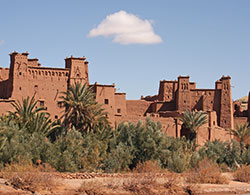
Photo by Lensw0rld / Adobe Stock |
Immerse yourself in the colorful tapestry of Morocco, where ancient traditions blend harmoniously with vibrant markets and breathtaking landscapes. Explore the bustling streets of Marrakech, and marvel at the intricate geometric tilework known as zellige, adorning buildings, fountains, and palaces, showcasing the meticulous craftsmanship inherent in Moroccan design.
|
Sip mint tea in a traditional riad, a traditional Moroccan home centered around an exquisite courtyard. Delight in the mosaic of Moroccan cuisine, savoring tagines and pastries in lively bazaars. Fez and Meknes unveil the mysteries of Morocco's medieval past through their labyrinthine medinas. Lose yourself in Fez's intricate web of narrow streets, stumbling upon hidden gems like the Al Quaraouiyine University, one of the oldest educational institutions in the world.
|
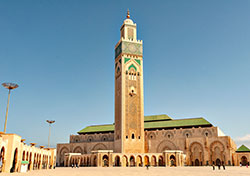
Photo by Kazu / Adobe Stock |
Visit iconic Casablanca, one of the country's largest cosmopolitan cities, located on the western coast of Morocco along the Atlantic Ocean. Casablanca is known for its modern architecture, bustling markets, and famous for its iconic Hassan II Mosque, one of the largest mosques in the world and a great example of Moroccan craftsmanship and architecture.
|
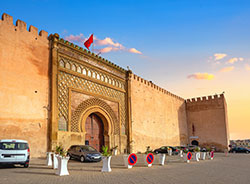
Photo by Valery Bareta / Adobe Stock | In Meknes, the allure of Morocco's historic Imperial City comes to life through its magnificent towering gates, such as the intricately adorned Bab Mansour. Beyond these gates lies a treasure trove of lavish monuments, including the grand Mausoleum of Moulay Ismail, reflecting the city's opulent past as the capital of the Alaouite Sultanate.
|
Delving into Meknes' medina (old town), retirees can savor the timeless charm of hidden courtyards adorned with colorful mosaics and bustling souks (markeplaces), where you can browse for souvenirs, spices, leather goods and clothing and admire the artistry of traditional craftsmanship. Souk el-Kebir is the largest and most famous souk in old town Marrakech, Morocco. While it's customary to haggle over prices, keep in mind the sellers in the souk are just trying to make a living. Also, be careful to not flash your money around, as this can make you a target for pickpockets.
|
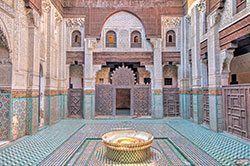
Photo by mehdi33300 / Adobe Stock | Immersed in a rich history that extends from Roman times to its zenith under Sultan Moulay Ismail, Meknes presents a vivid tapestry of cultural heritage. Visitors can explore the historic Medersa Bou Inania, a masterpiece of Moroccan architecture, and traverse the El Hedim Square, a vibrant hub surrounded by cafes and bazaars.
|
Amidst this historic backdrop, the city maintains its vibrant pulse, inviting retirees to partake in the pleasures of Moroccan life. As you journey through Morocco, the juxtaposition of its grand past and dynamic present beckons you to weave your own story in its enchanting blend of exploration and relaxation.
Tangiers, Morocco
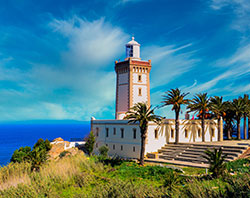
Photo by Casablanca Stock / Pexels | Only a 1.5 hour flight from Marakeesh is Tangier, Morocco. Tangier offers many intriguing historical sites such as the Medina, an ancient walled city and UNESCO World Heritage Site, with a maze of narrow streets, shops, and local crafts to explore. For a leisurely retreat, the city's serene beaches provide an ideal setting to unwind and soak up the Mediterranean sun. Visit the popular Cafe Hafa, a a cliffside cafe with stunning views of the Mediterranean Sea. |
| The Kasbah, a hilltop citadel, offers panoramic views of Tangier and the Strait of Gibraltar, providing a picturesque backdrop for travelers seeking breathtaking vistas. The serene beaches , and enjoy mouthwatering Moroccan cuisine such as couscous, tagine, and a variety of fresh seafood. Immerse yourself in the city's thriving art scene and local markets to discover aromatic spices, colorful textiles, and unique souvenirs that serve as tangible memories of your journey.
|
Earthquate Recovery
Morroco is still in a state of recovery from the 2023 earthquake. The tourism infrastructure in the city of Marrakesh, where the majority of tourists to the area travel to, is operating as normal. Before booking your trip, contact the hotel at your destination, or your travel agent, to ensure they are ready to host visitors. You can also visit these Websites to learn more the Morocco Department of Foreign Affairs or contact the Moroccan National Tourist Office (ONMT)
Best time to Visit Morocco:
Morocco enjoys a diverse climate with variations depending on the region. Generally, the best times to visit are in spring (March-May) and autumn (September-November).
Ramadan: If you plan to visit during Ramadan, some restaurants and shops might have adjusted hours.
Festivals: Morocco hosts various festivals throughout the year, which can affect accommodation availability and prices.
Spring (March to May):
Average Temperatures: 50-80°F (10-27°C)
Spring is a popular time to visit Morocco, as the weather is usually mild and pleasant. It's a great time to explore cities like Marrakech and Fes, as well as the desert regions.
Summer (June to August):
Average Temperatures: 85°F - 100°F (29°C - 38°C)
Summer can be quite hot, especially in inland regions like Marrakech and Fes. Coastal cities like Casablanca and Essaouira tend to have more moderate temperatures.
Fall (September to November):
Average Temperatures: 55°F - 85°F (13°C - 29°C)
Fall is another favorable time to visit Morocco, with warm and comfortable temperatures. It's a good time to explore the city, outdoor attractions and experiencing fewer crowds compared to the summer months.
Winter (December to February):
Average Temperatures: 40°F - 70°F (4°C - 21°C)
While generally mild, the High Atlas Mountains experience cold temperatures and snow. Coastal areas remain pleasant, but with shorter daylight hours.
Keep in mind that temperatures can vary significantly depending on the specific location within Morocco. Additionally, if you plan to visit the Sahara Desert, temperatures can be extremely high during the day and quite cold at night, regardless of the season
Ultimately, the best time to visit Morocco depends on your preferences for weather, activities, and the regions you want to explore. It's recommended to check the specific weather forecast for the cities or areas you plan to visit closer to your travel dates to ensure you pack appropriately and enjoy your trip to the fullest.
|
Best Time to Visit:
The best time to visit Africa can vary depending on the specific country, altitude and region. Note that some areas only have two seasons, while South Africa has four seasons. Generally, the dry season is ideal as it offers better wildlife sightings as there and more comfortable weather conditions. In East Africa, such as Kenya and Tanzania, the dry season runs from June to October. Southern Africa, including South Africa, Botswana, and Zimbabwe, experiences its dry season from May to October. It's important to research and consider the specific destinations and their seasonal patterns to choose the ideal time for your visit.
Travel Planning Tips
Regional Culture: There are many cultures on the African continent which vary by region. For more indepth information, visit our Regional Cultures of Africa page.
Transportation:
- Trains: Morocco has a national railway system, called the Office National des Chemins de Fer du Maroc (ONCF), which connects major cities including Casablanca, Rabat, Marrakech, Tangier, and Meknes. The ONCF also operates a high-speed line (LGV) between Tangier and Casablanca, which significantly reduces travel times between these two major cities.
- Buses: CTM is the largest national bus company, offering connections to most major cities and towns. Other private companies also operate bus routes, particularly in more rural areas.
- Trams: Rabat and Casablanca have modern tram systems that are a convenient way to get around these cities.
- Taxis: Petit taxis are small, metered taxis that are ideal for short trips within city limits. Grand taxis are larger shared taxis that travel between cities and towns. You can hail them at designated taxi ranks or negotiate a fare in advance for a specific journey.
- Walking: Exploring Morocco's medinas (old towns) and other historical areas on foot is a great way to experience the local culture and soak up the atmosphere. However, be aware that some areas may be crowded and navigating narrow streets can be challenging. It's also important to be mindful of the heat, especially during the summer months.
Safety Tips:
- Research the specific health risks of the regions you'll be visiting in Africa.
- Consult with a travel health clinic or your healthcare provider at least 6-8 weeks before your trip to discuss necessary vaccinations and medications for Morocco.
- Use insect repellent. While the risk of mosquito-borne diseases in Morocco is relatively low. There have been very few cases of malaria or dengue fever contracted within the country. However, it is still advisable to take precautions to avoid mosquito bites, such as using insect repellent and wearing long sleeves and pants when spending time outdoors, especially during dawn and dusk.
- Drink bottled water and avoid ice in drinks. Stay hydrated by drinking bottled or purified water throughout the day.
- Use bottled water for brushing your teeth.
- Wash your hands frequently with soap and clean water or use hand sanitizer.
- Carry hand sanitizer with you for situations where clean water and soap are not available.
- Eat only thoroughly cooked and hot foods.
- Avoid raw or undercooked seafood, meat, and dairy products.
- Be wary of street vendors and choose establishments with good hygiene practices.
- Carry a basic medical kit with essentials like pain relievers, bandages, antiseptic, and any personal medications.
- Protect yourself from the sun by wearing a wide-brimmed hat, sunglasses, and using a broad-spectrum sunscreen with a SPF 30 or higher.
- Seek shade during the hottest parts of the day (typically between 11am and 4pm). Its a good idea to wear a hat.
- Stay vigilant on public transportation and be aware of potential pickpocketing. Consider using a money belt. Be wary of anyone that tries to distract you, offers to help you such as assist with directions or helping to put your luggage on a train.
- Research and familiarize yourself with local emergency numbers and the nearest embassy or consulate in case of any emergencies. To call the Police (National Gendarmerie) dial 177, Ambulance: 150, Fire Department: 15. Or you can also use the general emergency number for the European Union, which is 112.
- Travel Advisories Stay updated on current events, local regulations, and any travel advisories when traveling abroad. Visit the US Government State Department Travel Advisories web site to check on the status of your destination.
- Enroll in the STEP Program: Travelers are also urged to enroll in the U.S. State Department's Smart Traveler Enrollment Program (STEP) to receive security messages and to make it easier to locate them in an emergency. The Department uses these security messages to convey information about terrorist threats, security incidents, planned demonstrations, natural disasters, etc. In an emergency, please contact the nearest U.S. Embassy or consulate or call the following numbers: 1 (888) 407-4747 (toll-free in the United States and Canada) or 1 (202) 501-4444 from other countries.
| |

Photo by Andrs / Adobe Stock
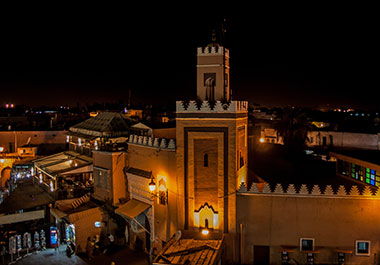
Romantic Marrakech
Photo by Cesare Palma / Adobe Stock
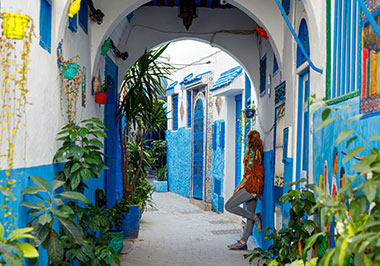 Tangers, Morroco
Photo by M.studio / Adobe Stock
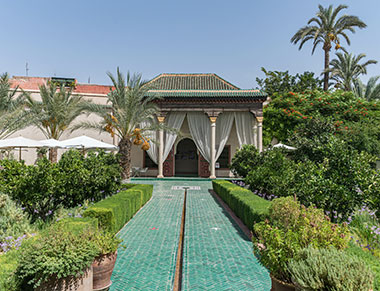
Photo by Driendl
|
 Photo by Andrs / Adobe Stock
Photo by Andrs / Adobe Stock Romantic Marrakech
Romantic Marrakech Tangers, Morroco
Tangers, Morroco Photo by Driendl
Photo by Driendl